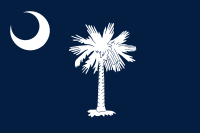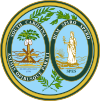The South Carolina Portal South Carolina (/ˌkærəˈlaɪnə/ ⓘ KARR-ə-LY-nə) is a state in the coastal Southeastern region of the United States. It borders North Carolina to the north, the Atlantic Ocean to the southeast, and Georgia to the southwest across the Savannah River. Along with North Carolina, it makes up the Carolinas region of the East Coast. South Carolina is the 40th-largest and 23rd-most populous U.S. state with a recorded population of 5,118,425 according to the 2020 census. In , its GDP was $213.45 billion. South Carolina is composed of 46 counties. The capital is Columbia with a population of 136,632 in 2020; while its most populous city is Charleston with a 2020 population of 150,227. The Greenville-Spartanburg-Anderson, SC Combined Statistical Area is the most populous combined metropolitan area in the state, with an estimated 2023 population of 1,590,636. South Carolina was named in honor of King Charles I of England, who first formed the English colony, with Carolus being Latin for "Charles". In 1712 the Province of South Carolina was formed. One of the original Thirteen Colonies, South Carolina became a royal colony in 1719. During the American Revolutionary War, South Carolina was the site of major activity among the American colonies, with more than 200 battles and skirmishes fought within the state. South Carolina became the eighth state to ratify the U.S. Constitution on May 23, 1788. A slave state, it was the first state to vote in favor of secession from the Union on December 20, 1860. After the American Civil War, it was readmitted to the Union on July 9, 1868. During the early-to-mid 20th century, the state started to see economic progress as many textile mills and factories were built across the state. The civil rights movement of the mid-20th century helped end segregation and legal discrimination policies within the state. Economic diversification in South Carolina continued to pick up speed during and in the ensuing decades after World War II. In the early 21st century, South Carolina's economy is based on industries such as aerospace, agribusiness, automotive manufacturing, and tourism. (Full article...)
Entries here consist of Good and Featured articles, which meet a core set of high editorial standards.
The Battle of Sullivan's Island or the Battle of Fort Sullivan was fought on June 28, 1776, during the American Revolutionary War. It took place near Charleston, South Carolina, during the first British attempt to capture the city from American forces. It is also sometimes referred to as the first siege of Charleston, owing to a more successful British siege in 1780. The British organized an expedition in early 1776 for operations in the rebellious southern colonies of North America. Delayed by logistical concerns and bad weather, the expedition reached the coast of North Carolina in May 1776. Finding conditions unsuitable for their operations, General Henry Clinton and Admiral Sir Peter Parker decided instead to act against Charlestown. Arriving there in early June, troops were landed on Long Island (now called Isle of Palms), near Sullivan's Island where Colonel William Moultrie commanded a partially constructed fort, in preparation for a naval bombardment and land assault. General Charles Lee, commanding the southern Continental theater of the war, would provide supervision. (Full article...)Selected article -
William Gilmore Simms (April 17, 1806 – June 11, 1870) was a poet, novelist, politician and historian from the American South. His writings achieved great prominence during the 19th century, with Edgar Allan Poe pronouncing him the best novelist America had ever produced. He is still known among literary scholars as a major force in antebellum Southern literature. He is also remembered for his strong support of slavery and for his opposition to Uncle Tom's Cabin, in response to which he wrote reviews and the pro-slavery novel The Sword and the Distaff (1854). During his literary career he served as editor of several journals and newspapers and he also served in the South Carolina House of Representatives. (Full article...) General images -The following are images from various South Carolina-related articles on Wikipedia.
Did you know -
|
Topics
Categories
New articles
Rules | Match log | Results page (for watching) | Last updated: 2024-05-12 21:41 (UTC)
Note: The list display can now be customized by each user. See List display personalization for details.
- Jayden McGowan (edit | talk | history | links | watch | logs | tools) by Butters.From.SouthPark (talk · contribs · new pages (36)) started on 2024-05-11, score: 20
- List of Pi Delta Epsilon chapters (edit | talk | history | links | watch | logs | tools) by Rublamb (talk · contribs · new pages (8)) started on 2024-05-11, score: 22
- Full Court Press (TV series) (edit | talk | history | links | watch | logs | tools) by Soulbust (talk · contribs · new pages (19)) started on 2024-05-11, score: 30
- WQIZ (edit | talk | history | links | watch | logs | tools) by Amakuru (talk · contribs · new pages (44)) started on 2024-05-10, score: 20
- Norman Greene (edit | talk | history | links | watch | logs | tools) by WikiQueenJT (talk · contribs · new pages (1)) started on 2024-05-09, score: 50
- Joshua Crockett (edit | talk | history | links | watch | logs | tools) by John Foxe (talk · contribs · new pages (1)) started on 2024-05-08, score: 20
- 2024 Crown Royal Purple Bag Project 200 (edit | talk | history | links | watch | logs | tools) by Tyman9348 (talk · contribs · new pages (4)) started on 2024-05-06, score: 20
- Girard, Montana (edit | talk | history | links | watch | logs | tools) by KjjjKjjj (talk · contribs · new pages (29)) started on 2024-05-06, score: 20
- 2024 Buckle Up South Carolina 200 (edit | talk | history | links | watch | logs | tools) by MysticCipher87 (talk · contribs · new pages (2)) started on 2024-05-05, score: 20
- The Secret Life of Bees (musical) (edit | talk | history | links | watch | logs | tools) by HesioneHushabye (talk · contribs · new pages (14)) started on 2024-05-05, score: 40
- Robert D. Hatcher (edit | talk | history | links | watch | logs | tools) by Suslindisambiguator (talk · contribs · new pages (5)) started on 2024-05-04, score: 31
- Claire Jimenez (edit | talk | history | links | watch | logs | tools) by Ruth Bader Yinzburg (talk · contribs · new pages (4)) started on 2024-05-04, score: 40
- Jefferson Marion Long Jr. (edit | talk | history | links | watch | logs | tools) by MoviesandTelevisionFan (talk · contribs · new pages (74)) started on 2024-05-04, score: 60
- Daniel E. Winstead (edit | talk | history | links | watch | logs | tools) by MoviesandTelevisionFan (talk · contribs · new pages (74)) started on 2024-05-04, score: 40
- Stephanie Mitchem (edit | talk | history | links | watch | logs | tools) by Jaireeodell (talk · contribs · new pages (1)) started on 2024-05-03, score: 20
- 2000 South Dakota Democratic presidential primary (edit | talk | history | links | watch | logs | tools) by Memevietnam98 (talk · contribs · new pages (29)) started on 2024-05-02, score: 30
- 2024 World's Strongest Man (edit | talk | history | links | watch | logs | tools) by Brandon Downes (talk · contribs · new pages (1)) started on 2024-04-30, score: 20
- 1990 NCAA women's golf championship (edit | talk | history | links | watch | logs | tools) by Hey man im josh (talk · contribs · new pages (652)) started on 2024-04-30, score: 48
- Higgins House (edit | talk | history | links | watch | logs | tools) by DemonDays64 (talk · contribs · new pages (1)) started on 2024-04-30, score: 20
- Hampton County High School (edit | talk | history | links | watch | logs | tools) by Bernardgeorgeh (talk · contribs · new pages (1)) started on 2024-04-29, score: 20
- Frank P. Dwyer (edit | talk | history | links | watch | logs | tools) by Pjbermel (talk · contribs · new pages (2)) started on 2024-04-28, score: 20
- Marion D. McGowan (edit | talk | history | links | watch | logs | tools) by MoviesandTelevisionFan (talk · contribs · new pages (74)) started on 2024-04-28, score: 60
- Alfred W. Bethea (edit | talk | history | links | watch | logs | tools) by MoviesandTelevisionFan (talk · contribs · new pages (74)) started on 2024-04-28, score: 70
- William Bratton (Revolutionary War) (edit | talk | history | links | watch | logs | tools) by CaroleHenson (talk · contribs · new pages (9)) started on 2024-04-28, score: 36
Related portals
WikiProjects
Associated Wikimedia
The following Wikimedia Foundation sister projects provide more on this subject:
-
Commons
Free media repository -
Wikibooks
Free textbooks and manuals -
Wikidata
Free knowledge base -
Wikinews
Free-content news -
Wikiquote
Collection of quotations -
Wikisource
Free-content library -
Wikiversity
Free learning tools -
Wikivoyage
Free travel guide -
Wiktionary
Dictionary and thesaurus













































